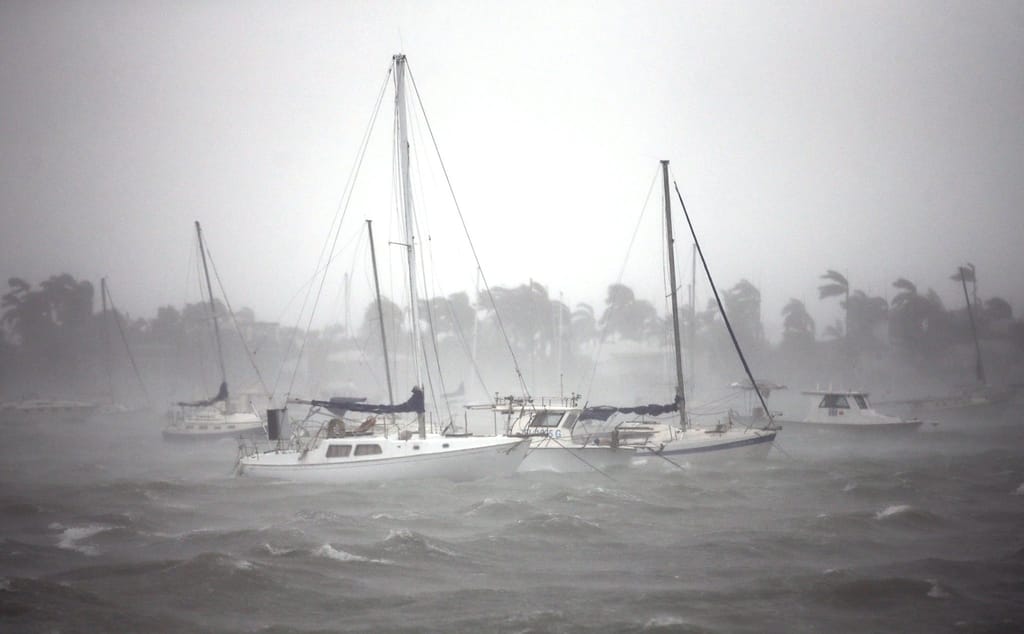How to Dock a Sailboat Before a Storm
We all know boats are safer ashore when there’s a storm coming. But, what can you do if you have to leave your boat in the slip? Generally, a boat’s success in weathering a storm is based on preparation, and of course, luck. And this applies to both anchored or moored boats, as a marina’s infrastructure can’t help that much once the wind starts howling. When your boat is on a mooring, you must secure the boat properly to minimize potential damage to your vessel and also to people around you in case your sailboat breaks loose of the mooring. But, let’s analyze a bit the best way to moor your sailboat before a storm and see some more information about storms and hurricanes. In this article, I’m going to walk you through the steps you need to follow to securely moor your boat. So, keep reading!
On Deck Preparation for Windage
Even if your sailboat is lifted out from the water, is located in a marina, or on a mooring, don’t forget to remove all parts and items that the wind can blow away. These are cockpit cushions, antennas, halyards, propellers, cradles, strops, and mooring lines, among others. Like this, you’ll reduce the loading on your and therefore making it much safer. Now, in case your sailboat is ashore under a winter cover then ensure that it’s tightly fitted. And, remember not to lash the cover to anything that supports the boat, like cradles and props, so that they won’t get pulled out of position in case of a gust. The best thing you can do is to take off the cover and stow it. Additionally, take off the bimini, tender, outboard, mainsail, headsail, spinnaker, and all overboard gear that is prone to wear and tear by the storm.
When you have unbent the mainsail, lash the boom to the toerail. Don’t forget to unbend the genoa and furl it tight. Keep in mind that the top of a furling genoa is the loosest part, so it’s essential to tighten the furl at the top. The sheets have to be wrapped around the sail twice, so keep furling until you get there. Also, to rest assured, consider threading a sail tie through the clew and tightly tie it around the sail. Securely cleat off the furling line and then tie a line from the genoa tack to the pulpit. Like this, you minimize the chances of unfurling.
In order to reduce windage, you have to unbend the mainsail, but you’d need someone to help you do it. If you don’t have someone, then add extra sail ties and tightly lash down the sail cover. This step is important as the amount of sail ties used and the securing system of the sail cover won’t be enough to hold the sail in place during a storm. The worst-case scenario is if the sail adds enough windage to make the boat drag its ground tackle.
When the loading capacity on a boat’s ground tackle surpasses the holding power of the ground tackle, the boat will drag. One of the most important factors that influence that load is the windage of the boat. Unfortunately, most of the time, a sailboat can’t lie perfectly head to the wind during a storm and tends to yaw from side to side. Bear in mind that even if a boat is on a mooring or anchored, the total loading on the ground tackle and the area exposed to the wind will differentiate. So, reducing the windage of your boat will also help reduce the total loading, and therefore help your boat stay put.
Will the Mooring Hold During a Storm/Hurricane?
Mooring your boat in a protected harbor will be much safer than mooring in a marina or canal. Bear in mind that when other boats are in proximity this will play a crucial role in terms of safety. Another important factor to consider when mooring is the type of bottom and the depth of the water. When a boat is on a sturdy mooring it can swing to face the wind, reduce windage, and thus it won’t collide on a dock unless the anchor or mooring drags.
However, you might ask yourself, how you can achieve a sturdy mooring. Or, will the mooring certainly hold in a hurricane? Well, most moorings have large and inflatable surface buoys. The thing with these buoys is their positive flotation. In other words, they tend to reduce the holding power of the mooring in high tides. So, consider removing the buoy before the storm arrives. Don’t forget to replace it after the storm is over and before casting off the mooring pendant.
One of the best types of mooring anchors is helix type that screws into the seabed. They tend to hold much better than mushroom or deadweight anchors. Mushroom anchors hold about 2 1/2 times their dry weight. However, helix anchors hold between 12,000 and 20,000 pounds. The downside with mushroom anchors is that they might take a set with the prevailing wind direction. But, the storm might come from a different direction. So, if you’re on a mooring or anchored, always check your mooring pennant and ensure that it has chafe protection.

Mooring Arrangement
The integrity of your ground tackle is what matters most here. So, consider putting the anchor and chain in the dinghy and row it towards the direction of the forecast gale. Then, throw it all over. Take in as much slack as possible without over-riding your mooring and tie a line to your mooring strop. To make sure that the anchor is set before taking in on the mooring line again, drop the line and motor the boat astern. Regarding the bottom, keep in mind that a Danforth-style anchor will grip better than other anchors. On the other hand, burying-type anchors in a normal bottom might be impossible to retrieve after a storm.
Of course, don’t omit considering the depth and bottom type. This is because a storm is likely to change the depth. So, it’s important to allow enough scope in order to prepare for the storm’s arrival. So, always test the holding ground beforehand. Like this, you can check which is the best holding ground. Soft and hard sand, soft mud, and clay are great holding grounds.
A great mooring arrangement is to use 2 or 3 anchors with chain rodes, placed 120 degrees apart, and connect them together using a heavy swivel. Or, set two anchors in linear formation and again connect them together by the chain at 90 degrees to the direction of the wind. It’s important to have the little fetch as possible in order to reduce the size of the waves.
You can also set 3 anchors in an array of 120 degrees and use the single swivel and line which leads to the boat’s bow. This can be applied when the boat has little room to swing. But, in case you plan to be anchored when the storm is coming always make sure to set at least three anchors. Moreover, prepare the adequate line, chain, and chafing gear to rig a hurricane mooring system. Lastly, always have enough anchor line and chain as well as a minimum of 100′ of line per anchor.
In all mooring and anchoring arrangements, don’t forget to increase the scope to allow for the storm surge. It’s advisable to do so at 10:1, if possible. Furthermore, use a heavy, oversized chain and line in an approximate 50/50 ratio for the bowline. In case you’re using an all-chain rode, use a sturdy snubber approximately 1/10 the length of the rode. Lastly, keep in mind that additional scope requires additional swinging room.
Storm Mooring Alternatives
If you’re anchored or moored during a storm the best thing to apply is to get out as much ground tackle as possible. If you have enough ground tackle and a good mooring then crashing into docks won’t be an issue. A problem may arise in case other boats drag down on you. This might lead to damaging your boat or even damaging your own ground tackle.
Keep in mind that the bigger the risk will be when your sailboat is tied to docks than being moored or anchored. Also, floating docks aren’t that strong to take the loads on them during a storm. And, in case the tides are extremely high, floating docks might float off the pilings which hold them in place. A boat kept at a dock can’t head into the wind because the storm winds change direction. As a result, when the boat is at a dock it is likely that it will have more windage than a boat secured to mooring or anchor. This is because when moored or anchored the boat is free to swing head to wind.
In any case, if you have to put your boat at a dock during a storm, always secure the lines to the pilings and not to the floating docks. Make sure to tie the lines high on the pilings so as to avoid chafing in case the docks ride up on the pilings. Use multiple clove hitches or a clove hitch for tying around the pilings. This way, the lines will tighten on the pilings, and won’t pull off even if the pilings go under.
Lastly, the safest alternative you can follow is storing your boat ashore. In general, boats stored ashore are far less likely to get damaged than those in the water. Many sailors prefer to haul their boats before the arrival of a hurricane or storm. However, for others, this tactic might not be easy at all, in case you can’t have immediate access on land as well as sufficient time.
>>Also Read: Why Insurance Companies Require Hurricane Plans
How to Face the Storm on a Mooring
Another important thing to check is the chafe on the mooring pennants. If the pennant shows signs of chafe then consider replacing it. Heavy-duty plastic tubing around the pennant might do the job to protect it from chafe. But, dry nylon lines heat up internally from the friction of stretching and shrinking. So, when putting a plastic cover over the nylon line you keep it dry but also cause it to corrode faster. It’s advisable that the mooring line uses braided polyester between the boat and the mooring buoy, with nylon below the mooring buoy.
Mooring lines can also be fitted with a Hazelett rode and backed up with a chafe-protected polyester line running from the boat to the mooring buoy. And remember, any line leaving your boat must have chafe protection on it. One of the best chafe protection is a 3-4ft of fender tubing from Davis Instruments. You can place it over your mooring line and secure it in place by sewing or with a lashing. With the lashing, the chafe protection won’t be able to slide down the anchor line.
You can also use an additional line from the bow to the mooring chain under the mooring buoy. Often when a mooring line snaps it is the swivel at the buoy that breaks. An additional line fed directly through the chain can give your boat an extra factor of safety. Also in a very severe storm, you might lay out your own anchor line to relieve the strain on the mooring line. Remember, though, that if the eye of the storm passes over you the wind direction will change, making your boat swing around and causing your anchor line to tangle in the mooring line. And the worst-case scenario would be to cause your mooring line to lift or break.
Prepare your Mooring
Most moorings can withstand storms and squalls. However, hurricanes pose an extra load on the anchor and anchor rode. So, before a storm hits, make sure that the mooring line is free of corrosion as it can weaken the chain and during a storm surge, it might even cause it to break. Also, inspect the shackles to make sure they’re tight, and remember that the anchors or mooring blocks have to be steadily embedded in the sea bottom. If you have any doubts about the chain, then consider moving to a new mooring or replace it, if possible. Checking the cleats on the bow of your boat is also of great importance. The cleats have to be fastened to guard against being torn out of the deck.
When the storm approaches don’t forget to double up your mooring lines or put a bridle around the bow of the sailboat to take the strain. In addition, check if there are no sharp edges around the bow of the boat that might cause wear and tear to the mooring line. Sometimes the stemhead fitting has a sharp edge at the corner of the deck. These edges might abrade the anchor line so keep an eye on them.
On an ideal mooring, the nylon line has to run from the buoy to the chain. Also, in the case of a helix mooring, use approximately 12 to 15ft of chain fastened to the helix mooring. Keep in mind that the line above the mooring buoy should be braided polyester. If employing this system then the scope of your mooring rode will be reduced and therefore the amount in which your boat swings will be cut down. But, the anchor will not be lifted off the seabed.
Useful Tips for Mooring the Sailboat Before the Storm
- Consider putting the fenders horizontally down the side of your boat, in case another boat breaks loose. Even though the fenders might not prevent damage, it will be considerably minimized if another boat comes down on your boat.
- Ensure that fuel and water tanks are topped up and that your sails are bent on. The additional weight of full fuel and water tanks will better stabilize the boat. However, if the boat breaks free, the full load of fuel will create a mess around.
- Your mooring anchors have to be large enough to take the weight of your boat. With a storm surge, a large boat will be able to lift the mooring anchors right off the seabed. If you’re not quite sure, then move to a heavier mooring before the storm hits. Keep in mind that using a Helix anchor which is screwed into the seabed by a diver is the most secure form of mooring. Nowadays, there are many sailors that carry a Helix anchor as an additional anchor.
- Consider stripping off all canvas to reduce windage. For example, biminis, awnings, mainsails, roller-furled jibs, and anything made out of fabric. Folding down the bimini or taking a few wraps of line around a furled sail is not good preparation. This is because when the wind gets up above 60 knots it tends to gradually destroy the whole cloth structure. Excessive wind can also damage any metal framework as it adds up stress on the whole boat.
- Arrange halyards properly so as to reduce flogging and damage to the fittings on the halyard. You can reduce windage and halyard slapping by tying all halyards off to a messenger line and run the halyards to the top of the mast. Like this, you reduce the number of lines that are exposed to the wind. Then tie the messenger off on a rail.
Best Way to Moor a Boat Before a Storm or Hurricane – The Bottom Line
Reducing windage, removing valuable gear, putting out extra lines, chafing gear, and prepare the anchors are the most important things to do for securing your boat before a storm. When you prepare for a storm it’s like preparing the emergency equipment. You’re hopefully never going to need it but in case you do it will be much better to be well-prepared and organized to deal with it. Keep in mind that the greatest preparation of your boat maximizes the chances of not damaging it. Lastly, remember to employ the best possible mooring for your boat and consider carrying a Helix anchor with you. Don’t forget to be equipped with chafe protection, a strong pennant, and a good mooring tackle, and you’ll be good to go. And when the storm passes the sun will shine up again!




